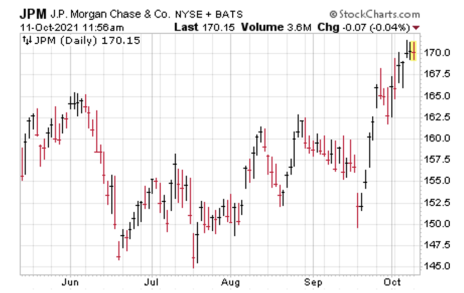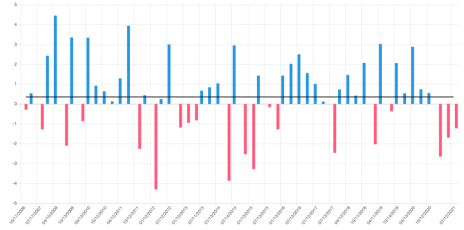This week is arguably the beginning of one of the most anticipated earnings seasons in market history.
The magic starts in earnest at the opening bell Wednesday when JP Morgan (JPM) and Delta Airlines (DAL)announce their earnings. And more companies follow suit as the week progresses with Morgan Stanley (MS), Bank of America (BAC), Citigroup (C), Wells Fargo (WFC), Goldman Sachs (GS), Walgreens Boots Alliance (WBA) and a few notable others.
[text_ad use_post='261460']
My approach to earnings is quite simple. I’m not trying to guess the direction of a stock after an announcement.
I’m simply taking a statistical approach.
Because every earnings announcement comes with uncertainty. And with that uncertainty comes heightened implied volatility as investors are either speculating to some degree or simply hedging their position. This is fact. Regardless, the increase in demand for options contracts leads to an increase in that underlying stock’s options prices, particularly during the week of the announcement.
I’m simply trying to find the best opportunities that the market has to offer during each earnings season and place statistically based trades on those that look the most promising.
The strategy is highly dependent on taking a quant-based approach. Again, focusing on the probabilities and allowing the law of large numbers to work its magic. But more importantly, a clear understanding of how to manage sequence risk when using a high-probability approach. I’ll be discussing all of this as we move through this earnings season.
One of Several Key Strategies to Trading Earnings
Iron condors are one, among several, of my go-to options strategies for trading around an earnings announcement.
The basic premise of the iron condor strategy is simple; choose a range that is typically outside of the expected move. Increasing the range will decrease your potential profits but will increase your probabilities of success.
As always, we only want to trade using highly liquid securities. I provide a screen of the most highly liquid stocks every week during earnings season which includes extensive research on each trade, including a screen for the best strategy to use.
For instance, take the heavily traded JP Morgan Chase (JPM). The company reports earnings before the opening bell next Wednesday and I’m curious how implied volatility looks for next week’s expiration cycle and the subsequent options prices.
The stock is currently trading for 170.15.
As soon as earnings pass, implied volatility (IV) is crushed, so we want to take advantage of the short-term heightened levels. Again, inflated volatility is one of the key components to making this a successful, long-term strategy which is why IV rank and IV percentile are key screens in finding the best stocks to trade. (I post this on the most notable earnings announcements every Friday during every earnings season.)
An above-average to extremely high IV rank simply tells us that we can sell options for fair-to-highly-inflated prices. And as anyone who has sold something knows, your preference is to always sell your product(s) for inflated prices. Options are no different.
Next, I like to take a historical look at prior earnings announcements for the stock I’m interested in trading. Going all the way back to 2006, the average move in JPM is roughly 0.5% with anomalies sitting just beyond a 4% move. Knowing how a stock responds around earnings gives me insight into how to approach the trade, or to simply avoid a trade altogether.
Now we need to find the expected move or expected range for our chosen expiration cycle. In most cases, we use the expiration cycle that is one to nine days after the earnings announcement. We chose the expiration with four days left for our JPM trade.
The expected move for JPM is roughly $9. There are several trading platforms that offer the expected move, I have found that Tastyworks, at least from a visual standpoint, offers the best information on expected moves.
Because we know the expected move, we have the ability to choose strikes outside of that area.
First, I look at the call side of the iron condor, also known as a bear call spread. I want to find a short call strike with around an 80% probability of success.
The October 15, 2021 175 calls fit the bill. It has a delta of 0.17 and a probability of success of 83.62%. The probability that JPM will touch the 175 call strike at expiration is 33.20%.
Once I’ve chosen my bear call spread, I look towards the put side, for my bull put spread, with the same goal in mind: a probability of success around 80% or higher.
The October 15, 2021 162.5 strike put works. It has a probability of success around 88.08% and a delta of 0.11. The probability of touch stands at 23.54%.
So, my starting range is from 162.5 to 175. Obviously, I could have used different strikes, but this is the typical starting point for my iron condor trades around earnings. Once I know my potential return at around the 80% probability of success level, I can alter my range accordingly.
What’s the Return?
If I sell, say, the 162.5 /160 bull put spread and the 175/177.5 bear call spread simultaneously, thereby creating an iron condor position, I have the ability to bring in roughly $0.40, for a potential max return of 19.0%.
Because we are using 2.5 wide strikes (162.5/160 and 175/177.5), our risk is $2.10 per iron condor (width of spread strikes minus amount of premium received or $2.5 – $0.40).
With JPM trading at roughly 170.00, the breakeven levels are 175.40 to the upside and 162.10 to the downside. Again, the probability of success on the trade is a staggering 88.08% at the 162.5 put strike and 83.62% at the call strike. Our breakeven probabilities are even greater.
I like those odds.
Remember, it’s all about taking advantage of the law of large numbers and the IV crush that is inherent in each and every earnings trade. Once you move away from the mechanics of the trade, you’re allowing emotions to seep into your decision making, and that is what we all want to avoid.
Risk Management – Don’t Overlook the Importance of Position Size
Because we are making short-term trades based purely on binary events, risk management as seen through strict position size is essential for long-term success. In fact, since the trades have little to no duration, there is rarely time to adjust a trade, therefore, again, position size is key.
We know through extensive research that roughly 80% of the expected move around earnings is larger than the actual movement of the stock.
Remember, we are trading math here. It’s all about allowing the probabilities to work themselves out, knowing that if the law of large numbers play out, our wins should far outweigh our losses. So, keeping our risk at reasonable levels is of the utmost importance.
There is so much more minutiae that occurs during an earnings season play. As a result, I will be including several videos on the site and some live sessions to go over the different scenarios one might face when trading earnings.
As always, if you have any question, please do not hesitate to email me.






